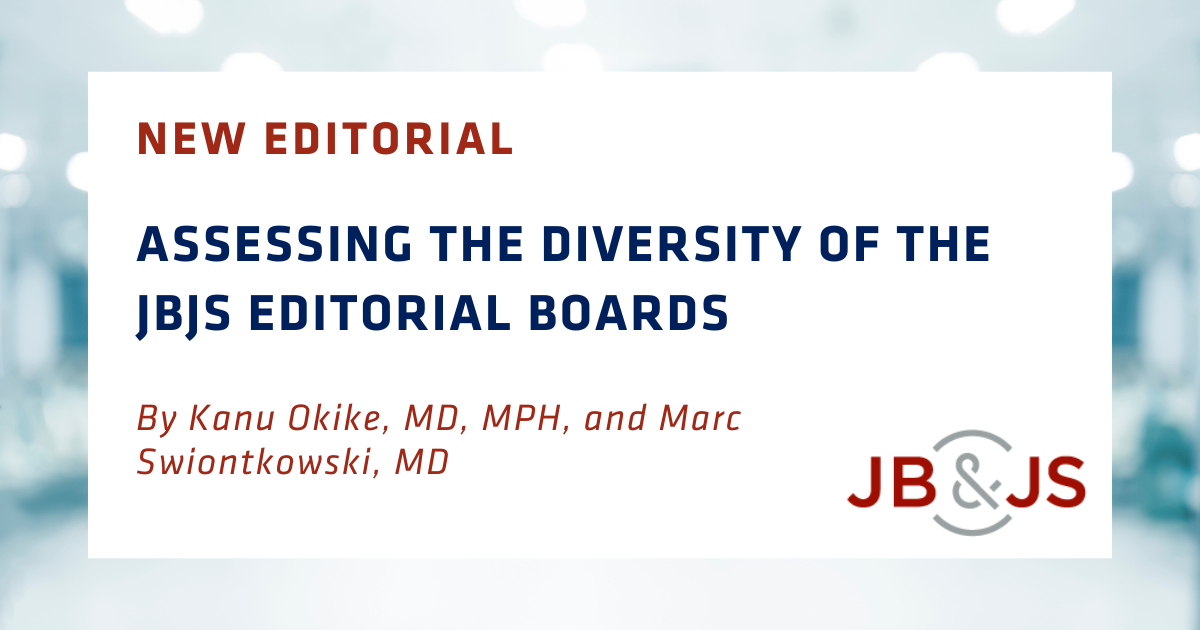“The first step in any effort to increase diversity is documenting the present state,” write Drs. Kanu Okike and Marc Swiontkowski in a new JBJS editorial. The Journal of Bone and Joint Surgery thus undertook an initiative last fall to assess the diversity of the JBJS team via a survey sent to the editorial boards across 6 journals, the Board of Trustees, and staff. Conducted anonymously, the survey was based on a questionnaire by Salazar et al. that was used in assessing editorial board diversity at 25 leading journals1.
Dr. Okike, Deputy Editor for Health Disparities, and Dr. Swiontkowski, Editor-in-Chief, discuss the results of the survey. The editorial is freely available at JBJS.org:
Editorial: Assessing the Diversity of The Journal of Bone and Joint Surgery Editorial Boards
From the editorial: “Some of the demographic variables examined in the editorial board survey, such as gender, race, and ethnicity, have been commonly assessed among orthopaedic surgeons in prior studies. For these variables, representation among JBJS editorial board members was generally found to be similar to that observed among orthopaedic surgeons as a whole, albeit with some exceptions. For example, individuals of Asian descent were found to comprise 18.9% of JBJS editorial board members compared with 6.7% of practicing surgeons, as documented in the most recent orthopaedic census2. Nevertheless, the representation of women (11.7%) and Black (3.6%) and Hispanic (1.8%) individuals on the JBJS editorial boards remains quite low relative to the population of patients treated by U.S. orthopaedic surgeons, which has been reported as comprising 50.4% women, 13.6% Black individuals, and 19.1% Hispanic individuals3.
“Other variables recorded in the survey, such as sexual orientation, have been less commonly assessed among orthopaedic surgeons previously. Although the representation of individuals identifying as heterosexual among JBJS editorial board members (90.9%) was similar to that among editors at top medical and scientific journals (88%)1 and the general population (87%)4, there were some differences in the representation of individuals identifying as asexual, bisexual, gay or lesbian, queer, questioning, and/or other.”
Access the full editorial and survey results:
Editorial: Assessing the Diversity of The Journal of Bone and Joint Surgery Editorial Boards
JBJS plans to administer the survey approximately every 3 years to assess for changes over time and seeks to continuously improve the survey to best measure demographics at JBJS.
“At JBJS, we consider the results of this survey to represent a baseline from which to grow and evolve,” notes the editorial.
Related reading on OrthoBuzz:
Editorial: The Reporting of Race and Ethnicity in The Journal of Bone & Joint Surgery
DEI Scholarship: New Editorial and Research in JBJS Open Access
OrthoJOE Podcast: Promoting Diversity in Orthopaedics and Equity in Health Care
References
- Salazar JW, Claytor JD, Habib AR, Guduguntla V, Redberg RF. Gender, Race, Ethnicity, and Sexual Orientation of Editors at Leading Medical and Scientific Journals: A Cross-sectional Survey. JAMA Intern Med. 2021 Sep 1;181(9):1248-51.
- American Academy of Orthopaedic Surgeons. Orthopaedic practice in the U.S. 2018. 2019 Jan. Accessed 2024 Jan. https://www.aaos.org/quality/practice-management/aaos-orthopaedic-surgeon-census/
- United States Census Bureau. QuickFacts: United States. 2023 Jul. Accessed 2024 Jan 22. https://www.census.gov/quickfacts/fact/table/US/PST045223
- Gallup. U.S. LGBT identification steady at 7.2%. 2023 Feb. Accessed 2024 Jan 24. https://news.gallup.com/poll/470708/lgbt-identification-steady.aspx



